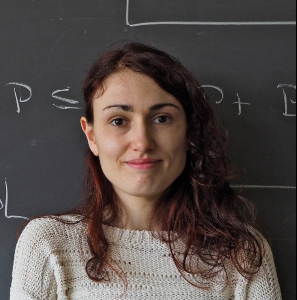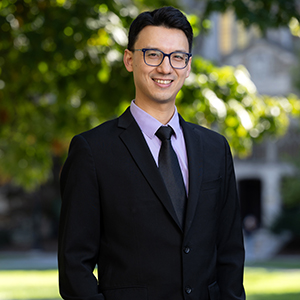2025 November Prize Spotlight
Congratulations to the SIAM prize recipients who will be recognized at the 2025 SIAM Conference on Analysis of Partial Differential Equations (PD25), taking place November 17-20, 2025 in Pittsburgh, Pennsylvania, United States.
- Cristiana De Filippis - 2025 SIAM Activity Group on Analysis of Partial Differential Equations Early Career Prize
- Ian Tobasco - 2025 SIAM Activity Group on Analysis of Partial Differential Equations Best Paper Prize
Cristiana De Filippis
Dr. Cristiana De Filippis, University of Parma, is the recipient of the 2025 SIAM Activity Group on Analysis of Partial Differential Equations Early Career Prize. She received the award “for outstanding contributions to the calculus of variations including new Schauder estimates and estimates for variational integrals using novel convex analysis, harmonic analysis, and potential theory.” She will deliver a prize lecture at SIAM PD25 on Wednesday, November 19 at 11:00 a.m. ET.

The SIAM Activity Group on Analysis of Partial Differential Equations Early Career Prize is awarded every two years to an early career researcher who has made outstanding, influential, and potentially long-lasting contributions within six years of receiving the Ph.D. or equivalent degree as of January 1 of the award year. At least one of the papers containing this work must be published in English in a peer-reviewed journal or conference proceedings.
Dr. De Filippis, born in 1992, is full professor of mathematics at the University of Parma, Italy. Her research focuses on the (ir)regularity theory of elliptic and parabolic partial differential equations, with particular emphasis on problems arising from the Calculus of Variations. Over the years, she has been recognized for her work through being elected to the inaugural cohort of the European Mathematical Society Young Academy (2023) and being awarded the 2020 Italian National Academy Iapichino Prize, the 2023 Italian Mathematical Society Bartolozzi Prize, the 2024 European Mathematical Society Prize, and a 2025 European Research Council Starting Grant. Learn more about Dr. De Filippis.
Q: Why are you excited to receive the award?
A: I’m excited because this award is prestigious, it comes from a prestigious institution, and it certifies that my work has attracted the interest of a panel of distinguished mathematicians.
Q: Could you tell us about the research that won you the award?
A: Schauder theory is a basic tool in the study of elliptic and parabolic partial differential equations (PDEs), which asserts that solutions inherit the regularity of the coefficients. It plays a central role in establishing higher regularity for solutions to a broad class of elliptic problems, including those involving free boundaries. In the linear setting, Schauder theory dates back to the 1920s-30s and is now considered standard. Nonlinear extensions were developed in the 1980s. All these classical results are restricted to uniformly elliptic operators and heavily rely on perturbative techniques. However, such methods fail in the nonuniformly elliptic setting, where homogeneous a priori estimates break down and standard iteration arguments no longer apply.
A genuinely new phenomenon emerges here: Schauder estimates are in general no longer perturbative, as shown by counterexamples, and since the 1960s, proving regularity of solutions required assumptions that ruled out the applicability of classical Schauder theory in the nonuniformly elliptic case. The validity of Schauder theory in this context had long remained an open issue. I was awarded the 2025 SIAM Activity Group on Analysis of Partial Differential Equations Early Career Prize primarily for resolving this problem. Together with Giuseppe Mingione from the University of Parma, we established the validity of Schauder theory under optimal assumptions for nonuniformly elliptic problems.
Q: What does your work mean to the public?
A: PDEs are the language of physical systems. They model continuous phenomena: heat conduction, wave propagation, fluid dynamics, electromagnetism, quantum mechanics, and elasticity all find their natural mathematical formulation in PDEs. My research develops novel techniques to understand how regular or irregular their solutions can be, a fundamental step toward predicting, approximating, and ultimately controlling the behavior of complex systems that shape science, technology, and everyday life.
Q: What does being a member of SIAM mean to you?
A: Although I am not currently a SIAM member, I deeply value SIAM’s role in fostering connections across analysis, PDEs, and applied mathematics. Receiving this award highlights the importance of that community, and I look forward to engaging more closely with SIAM in the future.
Interested in submitting a nomination for the SIAM Activity Group on Analysis of Partial Differential Equations Early Career Prize? The prize next opens for nominations on May 1, 2026.
Ian Tobasco
Dr. Ian Tobasco, University of Michigan, is the recipient of the 2025 SIAM Activity Group on Analysis of Partial Differential Equations Best Paper Prize. He received the award for his paper, “Curvature-Driven Wrinkling of Thin Elastic Shells," Archive for Rational Mechanics and Analysis, Vol. 235, pp. 1211-1325 (2021). The paper “studies wrinkling patterns seen in thin elastic shells. Using tools from the calculus of variations, the paper develops an elegant and deep theory with amazing predictive power.” Dr. Tobasco will present the paper in a talk at SIAM PD25 on Wednesday, November 19 at 1:15 p.m. ET.

The SIAM Activity Group on Analysis of Partial Differential Equations awards this prize every two years to the author(s) of the most outstanding paper, as determined by the prize committee, on a topic in partial differential equations published in the four calendar years preceding the award year.
Dr. Tobasco is an associate professor of mathematics at the University of Michigan, where he has been since fall 2025. He earned a B.S.E. in aerospace engineering from the University of Michigan (2011) and a Ph.D. in mathematics from the Courant Institute of Mathematical Sciences at New York University (2016). Previously, he held positions at Rutgers University and the University of Illinois Chicago. Dr. Tobasco’s research focuses on nonlinear elasticity and the calculus of variations. Currently, he is working toward a mathematical theory of the wrinkle-to-fold transition in confined elastic sheets and the derivation of homogenized theories for shape-changing mechanical metamaterials like origami and kirigami. He also received an NSF CAREER award (2022). Learn more about Dr. Tobasco.
Q: Why are you excited to receive the award?
A: I am thrilled to have been selected for the SIAM Activity Group on Analysis of Partial Differential Equations Best Paper Prize. It is a great honor to be in the company of people whose work I have admired for years. I am grateful to the selection committee for choosing to highlight my work on wrinkling patterns out of the many wonderful contributions that have recently appeared on the subject of partial differential equations.
Q: Could you tell us about the research that won you the award?
A: I studied the wrinkle patterns that form when a thin elastic shell is confined to a geometry other than its own. Gauss’s famous theorem egregium says that there is an obstruction to isometrically deforming a surface into another one with a different Gauss curvature. Nevertheless, if one tries to stamp a curved elastic surface into a plane—one whose metric is allowed to deform at a finite energy cost—then the surface can wrinkle in response. I developed a mathematical theory to describe these wrinkles, based on the techniques of convex analysis and Gamma-convergence. I found a way to predict the wrinkle patterns of various elastic shells by solving a convex variational problem in the high-frequency limit. In this way of modeling wrinkles, the energetically preferred patterns of peaks and troughs become the extreme points of a convex set. Given the parameters of the shell, one can solve for the relevant extreme point and draw the wrinkles it predicts. This new way of deducing wrinkle patterns led to a successful collaboration with physicists who verified the predictions using extensive experiments and numerical tests.
Q: What does your work mean to the public?
A: Wrinkling has been a topic of study in engineering mechanics, soft matter physics, and mathematical materials science for many years. It is one example of a “many body” elasticity problem where the individual bodies are the wrinkles, and their interaction involves the imposition of a preferred metric or length constraint. Another example from my recent work is to figure out what sorts of shapes slightly stressed origami surfaces make when the number of folds is large. I hope that my research on these topics and related problems helps inspire future generations to get involved with the many open challenges that remain in the modern theory of soft matter and deformable materials. There is quite a lot of room for mathematicians to contribute to this active and highly interdisciplinary research area.
Q: What does being a member of SIAM mean to you?
A: SIAM conferences are a joy to attend. I remember going to my very first SIAM conference as an early graduate student and meeting people that continue to play a key role in my career today. I send my own students to SIAM conferences now and am a frequent co-organizer of mini-symposia. I thank SIAM and its staff for doing such a great job fostering interdisciplinary collaborations and creating a welcoming space for early career professionals. I look forward to participating in SIAM for many years to come.
Interested in submitting a nomination for the SIAM Activity Group on Analysis of Partial Differential Equations Best Paper Prize? The prize next opens for nominations on May 1, 2026.
Related Reading



Stay Up-to-Date with Email Alerts
Sign up for our monthly newsletter and emails about other topics of your choosing.



